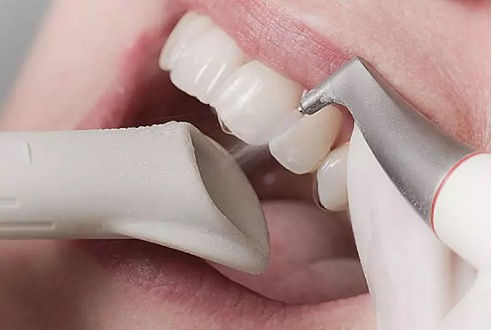Benefits of Airflow with the Hygienist
- rishipatel92
- Jul 30
- 2 min read
Updated: Aug 4
A Gentle Revolution in Dental Hygiene: The Power of Airflow Cleaning
When it comes to professional dental cleaning, Airflow polishing is quickly emerging as a preferred alternative/addition to traditional scale & polish treatments. Here’s what makes it special:
💦 What Is Airflow Dental Cleaning?
Airflow cleaning uses a fine, pressurized stream of compressed air, warm water, and micro‑powder particles to gently blast away plaque, biofilm, and surface stains. It’s effective above and just below the gumline, without requiring scraping.

✅ Key Benefits of Airflow Cleaning
1. Complete Stain, Plaque and Biofilm Removal to prevent Decay and Gum Disease
Ideal for removing surface stains caused by coffee, tea, tobacco, and certain foods. Airflow treatment lifts away discoloration and soft deposits before they harden into tartar. It substantially reduces invisible layer of bacteria (biofilm), helping prevent buildup over time and even helps prevent dental decay and gum disease.
2. Non-Invasive & Comfortable
No scraping or vibrations—Airflow delivers a gentle yet thorough clean. Patients with sensitive teeth, veneers, crowns, implants, or braces find the experience far more pleasant than traditional methods, with enhanced results.
3. More Efficient
Airflow is typically done within your normal hygienist appointment, due to it being more effective and efficient at removing staining, plaque and the biofilm.
4. Improved Gum Health
Airflow reaches targeted areas around the gumline, just below the gumline and into gum pockets, helping to reduce inflammation and bacterial biofilm without damaging delicate gum tissue.
5. Better Breath & Feel
Posts-treatment, patients consistently report a smoother enamel surface, a fresh clean mouth, and noticeably fresher breath.
6. Safe for Restorative Work
Because it’s low‑abrasive and non-heated, Airflow cleaning is suitable for visible and hidden dental work—such as crowns, bridges, implants, and orthodontics.

⏱️ Typical Appointment Overview
Pre-treatment assessment The hygienist examines oral health, staining levels, and suitability. If hard tartar or heavy calculus is present, traditional scaling may be required first.
Airflow polishing A fine jet of warmed water, compressed air, and micro‑powder is directed at each tooth, targeting front, back, interdental areas, and the gumline. High‑volume suction keeps the area clear.
Rinse Teeth are rinsed; patients may experience smoother enamel and fresher breath.
📅 How Often Should You Get It?
General maintenance: every 6–12 months
Gum disease or gingivitis: quarterly (approx. every 3 months) to manage biofilm and inflammation non‑invasively
📝 Final Thoughts
Airflow cleaning blends comfort, speed, and a deep-felt clean, making it a worthwhile investment in both smile aesthetics and oral health. With its non-abrasive nature and stain-lifting capability, it’s especially suited to those prone to staining, sensitivity, or wearing dental appliances. However, for thorough removal of hard deposits, conventional scaling still has its place.
When performed by a trained hygienist, Airflow can elevate your dental experience, delivering results faster, gentler, and often in half the time.
Contact us at Pitshanger Dental in Ealing to arrange your visit and experience Airflow




Comments